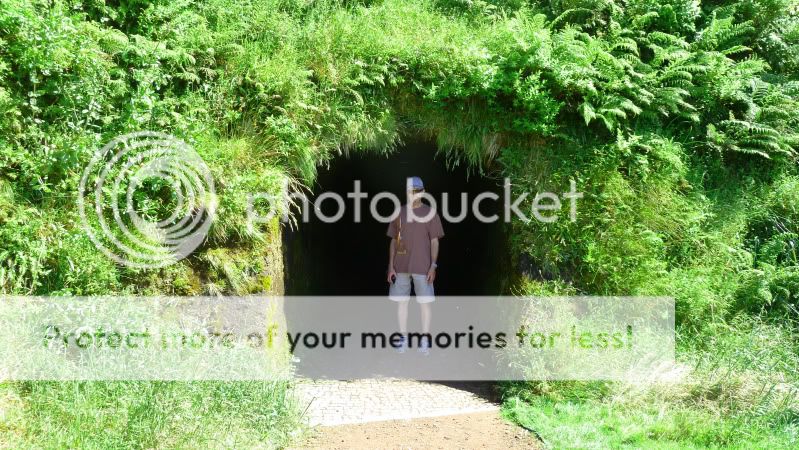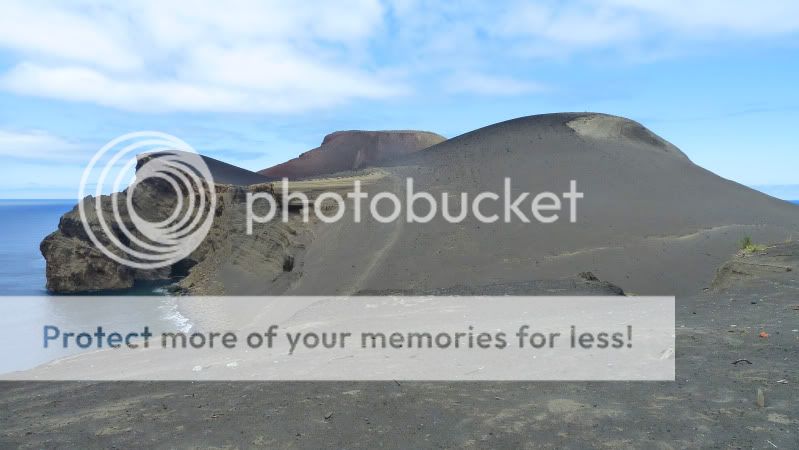Honeymoon TR: Island of Faial
(Last Updated On: )
The island of Faial has more to offer than just the amazing port-town of Horta. There are volcanoes and lighthouses, beaches and beautiful sights every where you go.
In order to explore Faial outside of Horta, we rented a car. Faial is small, being only about 7 miles long and 5 miles wide. We began heading west first, out of Horta, enjoying the fantastic coast line along the way.

The coast line with the volcanic moonscape of Capelinhos in the distance.

Capelinhos is a very interesting site. In 1957, a volcano began to erupt just off the coast of Faial. It erupted several times within the course of about a year. First below the sea, the volcano eventually grew to above sea-level. Eventually, the lava flow grew enough to attach itself to the island of Faial. Faial was suddenly about 1 and 1/4 square miles bigger. In the process, a lighthouse that was once right on the coast became partially buried in volcanic ash. It still stands today, seen in this photo.

Check out photos and read about the events of this well documented eruption on the Capelinhos website.

Despite its lack of vegetation, Capelinhos is still beautiful.

Near the Capelinhos lighthouse, there is a swimming area. As I said previously, the Azores are not known for their beaches. They don’t have very many of them. But, they do have many of these developed swimming areas among the rocks along the coast. They are quite nice.

Today, the lighthouse has become a museum. Don’t let the size fool you. The museum is largely underground, with rooms upon room telling the story of the eruption, describing how volcanoes form and the different types, and highlighting major volcanoes world-wide. There are videos and holograms, among other cool audio-visual displays.

After Capelinhos, we continued on our island tour. This view overlooks the village of Praia do Norte.

More beautiful coast line with Hydrangeas in the foreground. Hydrangeas have been planted all over Faial- so many that it is often called “the blue island”.

Many of the roads are bordered with Hydrangeas.

A beautiful valley on the northern side of the island.

The valley is densely covered with lush foliage, besides the ubiquitous Hydrangeas.

Hydrangeas are even used in place of traditional fences, as seen in this photo.

In the afternoon, we headed to the top of the volcano, called the Caldeira.

A tunnel leads to hiking access.

There is a hiking trail that follows the entire circumference of the Caldeira. Though we didn’t have time to do the whole hike (about 2.5-3 hours, and we needed to have the car back by 5:30) we walked along the rim for a ways.

It was spectacularly beautiful.

Perhaps the best part about the Caldeira were the views of neighboring Pico. The clouds made for a surreal scene.

After the Caldiera, we headed to Praia do Almoxarife. Not only is this town the home of the original Flemmish settlers back in 1467, but it boasts one of Faial’s best beaches.

Everyone was swimming, and so did we. Like many of the Azores beaches and swimming spots, Praia do Almoxarife was equipped with full changing facilities including showers.

With our day complete, we headed back to wonderful Horta.

Next up- the island of Pico!
Complete List of Honeymoon Trip Reports:
Barcelona
Gaudi
Spanish Pyrenees
Climb of Tosa d’Alp
Cardona Castle
Montserrat
Five hours in Lisbon
Horta Part I
Horta Part II
Island of Faial
Island of Pico, Day 1
Portugal and The Azores Highest Point: Montanha Do Pico 7,713′
Watching Whales & Swimming with Dolphins
Pico Adegas, Gardens, and More
Island of Pico
- Mount Buckskin (17 May 2020) - May 28, 2020
- Horseshoe Ski (14 May 2020) – The mountain whose journey nearly killed me - May 27, 2020
- Sayres X-Rated Ski (10 May 2020) - May 19, 2020








